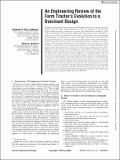An Engineering Review of the Farm Tractor's Evolution to a Dominant Design
Author(s)
Díaz Lankenau, Guillermo F; Winter, Amos G
DownloadPublished version (3.878Mb)
Publisher Policy
Publisher Policy
Article is made available in accordance with the publisher's policy and may be subject to US copyright law. Please refer to the publisher's site for terms of use.
Terms of use
Metadata
Show full item recordAbstract
©2019 by ASME. This paper explains the origin and merits of the dominant farm tractor design, which has endured since the 1940s. Understanding the origins and rationale for this dominant design enables engineers to appreciate its merits, and understand its drawbacks, which could be addressed in future designs. Additionally, the methods used in this paper to study tractor evolution are applicable to the study of other products with a longstanding dominant design. Two themes are covered in this paper: first, the historical context that directed the farm tractor's design evolution is presented; and second, a terramechanics-based tractor model is used to analyze why the dominant design is conducive to good performance. The prominent characteristics of the dominant tractor design are its weight distribution, wheel layout, tool location, and construction. Its weight distribution maximizes drawbar pull by placing 70 to 80% of the total vehicle weight on the rear wheels. Shifting the weight forward reduces pulling force while shifting it backward produces a negligible increase in pulling capacity while dangerously increasing the risk of upending the tractor. The tractor has four wheels arranged in a rectangular pattern-the rear wheels are driven while the front ones are usually idle. Rear wheels are of large diameter to increase ground clearance and tractive efficiency. Front wheels are of small diameter to allow for a large steering angle despite a narrow track width. A narrow track width reduces the space required for making a U-Turn at field ends and improves access to farm spaces. Inline front and rear wheels are desirable for ease of driving between rows and to best harness soil compaction. Attaching implements behind the rear axle leverages tillage forces to increase maximum drawbar pull and enables using large tools. The tractor's crankcase and transmission housing are structural components-this reduces mass and manufacturing complexity.
Date issued
2019Department
Massachusetts Institute of Technology. Global Engineering and Research Laboratory; Massachusetts Institute of Technology. Department of Mechanical EngineeringJournal
Journal of Mechanical Design
Publisher
ASME International